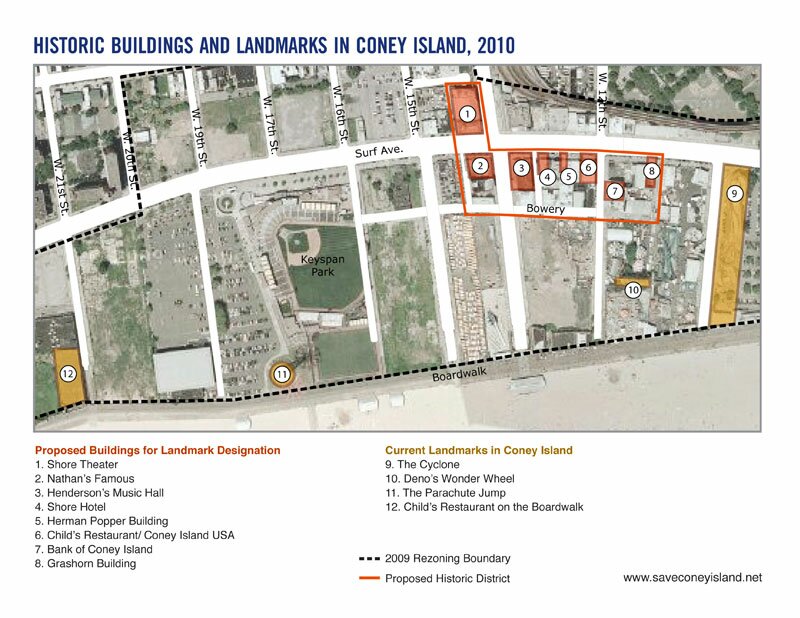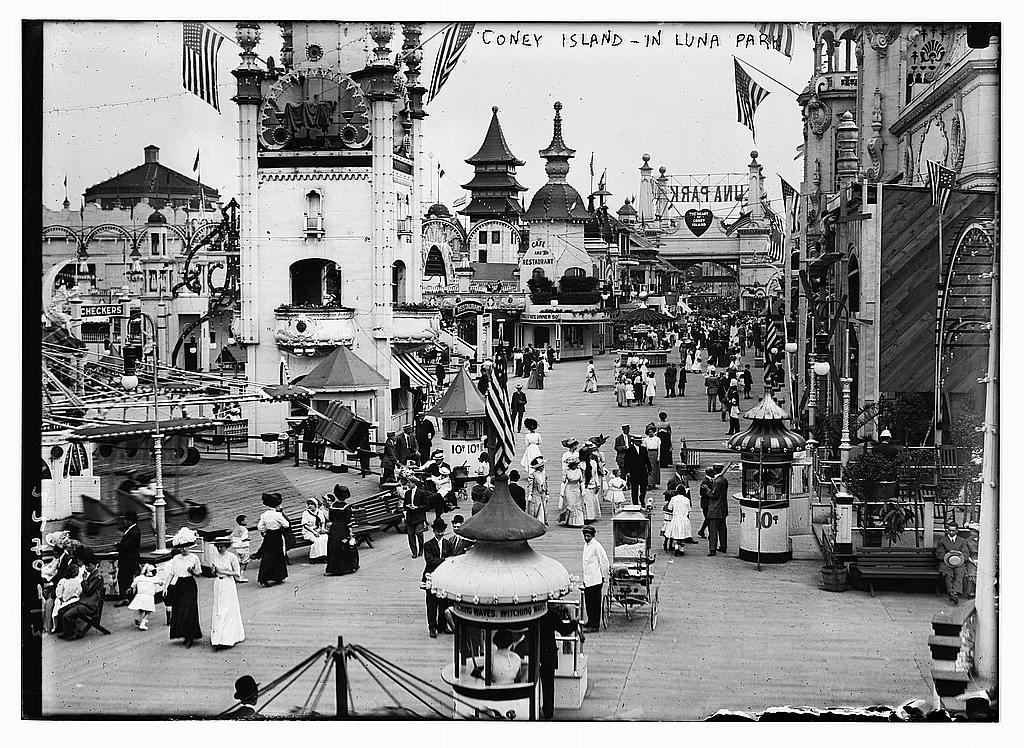The Parachute Jump and the boardwalk.
After a recent field trip to Coney Island, I got thinking more seriously about its future. A major rezoning last year has paved the way for transformative development in this otherwise forgotten corner of Brooklyn. And with all of this new attention, there's a lot of talk about how to keep the spirit and texture of Coney Island alive.
Groups like Coney Island USA and Save Coney Island are advocating for the creation of a small Coney Island Historic District.
Proposed Historic District and Current Landmarks map via Save Coney Island.
The only existing NYC landmarks in Coney Island are: The Parachute Jump, The Cyclone, The Wonder Wheel, and Childs Restaurant on the Boardwalk. And, I must say, I love each of them. Childs is a wonderful, romantic, decaying relic of terracotta in oceanic themes. The Cyclone is still a thrill for kids of all ages, including me. And, like the Cyclone, the Parachute Jump and the Wonder Wheel are important living memories of summers past for many New Yorkers.
Childs Restaurant on the Boardwalk, above, and thrills on the Cyclone, below.
Attempts to landmark a few, heavily altered buildings appear to be dead in the water. These buildings are significant not for architectural integrity but their cultural history. I have no issues with designating cultural landmarks, and doing so for Shore Theater and Nathan’s Famous (see below) would be a nice olive branch given the scale of development that the city envisions.
The Shore Theater, above, and Nathan's Famous, below.
Landmarking these buildings won't “save” Coney Island. Nor will a small district. In this case, an historic district can only hint at what was once common: a richly varied place full of visual chaos, wild amusements, fanciful entertainment, and cheap thrills. I say, instead, focus on making Coney Island a rich, diverse, wildly entertaining place for New Yorkers of every stripe.
Surf Avenue Coney Island, c. 1910 Library of Congress , Flickr Commons Project.
In 2009 the rezoning of Coney Island advanced a new city vision of developer-driven change for Coney Island: one in which hotel and residential towers commingle with neighborhood scale retail, and the amusement areas would be condensed to the area between the ballpark and aquarium. I can understand the concentration of games and rides into one location, and I see the value in making it a more year-round destination. Encouragement new development for Coney Island is also a great goal, though I fear the possibility of homogenization, mediocrity, and privatization of the amusements and amenities. Coney Island is a place for everyone and it should stay that way. (Even if the Cyclone costs $8 for your first ride, the beach is but a subway fare away.)
Inside Luna Park, Coney Island, Library of Congress Print and Photograph collection.
Inventive eye-catching attractions and fringe amusements have always characterized Coney Island as New York’s great playground, making it a seaside destination of choice. Opportunistic developers who used their imaginations made that happen. I would hope that any new development – especially those benefitting from the city’s rezoning or through financial incentives – would keep that in mind.
One feature of Coney Island I feel very strongly about keeping firmly in its place is the boardwalk. This should be designated as a Scenic Landmark, the same way Eastern and Ocean parkways are. What would Coney Island (or Brighton Beach) be without its boardwalk? The city should be obligated to maintain it in perpetuity to ensure uninterrupted public access. Coney Island has had a boardwalk since the 1920s, and it should stay that way.
Coney Island may be a shadow of its former self, but it has good bones. There’s incredible potential for a renewed Coney Island to demonstrate the values that make New York great: world-class public amenities, imaginative development, and something for everyone. I don’t see the zoning process or landmarking bringing that about on its own. The large land-holders, like New York City and Thor Equities, need to consider very carefully and think creatively about how to invigorate Coney Island as a richly textured destination. This could be achieved with fine-grained smaller site development, and making space for a large variety of small vendors, kiosks, and games, particularly close to the boardwalk. It should feel like a bizarre bazaar, not a monolithic or sterile place.
The Bowery, Coney Island c. 1912, Library of Congress, Print and Photograph Collection.
Coney Island could thrive anew with a density of creative and interesting, amusements and amenities that would attract New Yorkers of every stripe. There are plenty of vacant lots to build on: start there. Restore Childs on the Boardwalk to anchor an otherwise desolate stretch of boardwalk. Encourage vendors to extend the small shops along the boardwalk to keep it lively and affordable.
Developers, property owners, and the city alike should strive to make Coney Island an adventure, but keep it real.
For More Information check out:
The NYC Department of City Planning's Coney Island rezoning info here.
Coney Island USA's website.
Library of Congress's Sanborn Time Series on Coney Island here.
Library of Congress's Flickr Commons Project Coney Island collection here.
Color photos by Preservator, all rights reserved.










No comments:
Post a Comment